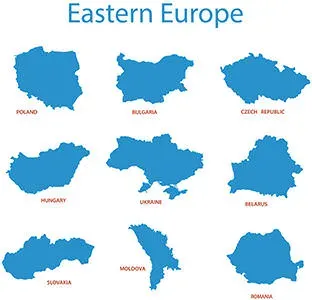 Though the term "Eastern Europe"" has been used to describe many different configurations of countries over time, the area sketched in this essay will generally cover the countries currently listed with the UN: Belarus, Bulgaria, the Czech Republic, Hungary, Poland, the Republic of Moldova, Romania, the Russian Federation, Slovakia and Ukraine. This list is based primarily on geography, whereas many older lists have more to do with politics: the name changed as borders, religions and culture shifted over time."
Though the term "Eastern Europe"" has been used to describe many different configurations of countries over time, the area sketched in this essay will generally cover the countries currently listed with the UN: Belarus, Bulgaria, the Czech Republic, Hungary, Poland, the Republic of Moldova, Romania, the Russian Federation, Slovakia and Ukraine. This list is based primarily on geography, whereas many older lists have more to do with politics: the name changed as borders, religions and culture shifted over time."
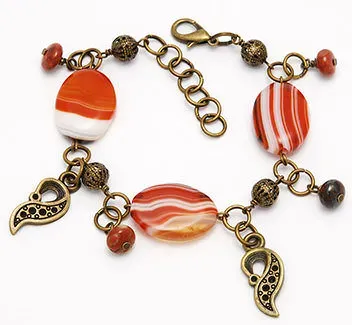 Jewelry has been found in excavations from Neolithic Slovakia, which was then a large copper manufacturing center. As the turn of the millennium neared, jewelry was being produced all over the region now known as Eastern Europe and was being actively traded along with other goods throughout Greece and Russia. In the first century AD, for example, the ancient city of Olbia had already been a colonial trading post for Greeks for some time. Living in Olbia were Greeks, nomadic Scythians and Sarmatians ï¾– an ancient people thought to be the ancestors of both Poles and Lithuanians. Locals received gold and silver from Romans in exchange for salt, grain and other local staples. These metals were used to create a variety of precious objects and the people of this town on the northern coast of the Black Sea became accomplished goldsmiths. Common among women were earrings, necklaces, bracelets (often worn in pairs), brooches, and even strings of beads for the head. Pieces survive from this area and era that show beautiful dark sardonyx stones cut into teardrop shapes, set into serrated gold and adorned with twisted filigree and granulation. These elaborate settings were then further decorated by dangly delicate chains that ended with glass beads.
Jewelry has been found in excavations from Neolithic Slovakia, which was then a large copper manufacturing center. As the turn of the millennium neared, jewelry was being produced all over the region now known as Eastern Europe and was being actively traded along with other goods throughout Greece and Russia. In the first century AD, for example, the ancient city of Olbia had already been a colonial trading post for Greeks for some time. Living in Olbia were Greeks, nomadic Scythians and Sarmatians ï¾– an ancient people thought to be the ancestors of both Poles and Lithuanians. Locals received gold and silver from Romans in exchange for salt, grain and other local staples. These metals were used to create a variety of precious objects and the people of this town on the northern coast of the Black Sea became accomplished goldsmiths. Common among women were earrings, necklaces, bracelets (often worn in pairs), brooches, and even strings of beads for the head. Pieces survive from this area and era that show beautiful dark sardonyx stones cut into teardrop shapes, set into serrated gold and adorned with twisted filigree and granulation. These elaborate settings were then further decorated by dangly delicate chains that ended with glass beads.
 The earrings were likely a part of a rich woman's attire for the afterlife. Both Sarmatians and Scythians buried their dead with valuable possessions. Because of frequent trade, items of Roman manufacture appeared in Eastern European graves as far north as Scandinavia, including silver cups and jewelry. Trade went both ways, and because of high demand for
The earrings were likely a part of a rich woman's attire for the afterlife. Both Sarmatians and Scythians buried their dead with valuable possessions. Because of frequent trade, items of Roman manufacture appeared in Eastern European graves as far north as Scandinavia, including silver cups and jewelry. Trade went both ways, and because of high demand for ![]() amber in the Roman Empire, the people of the Baltic grew rich on the translucent orange stone. Elite gravesites throughout Baltic States around the year 200 AD included many interesting valuables, including gold ornaments intended for horses set with glass and semi-precious stones. Bronze jewelry carved into curvilinear forms at times incorporated handsome animal forms.
amber in the Roman Empire, the people of the Baltic grew rich on the translucent orange stone. Elite gravesites throughout Baltic States around the year 200 AD included many interesting valuables, including gold ornaments intended for horses set with glass and semi-precious stones. Bronze jewelry carved into curvilinear forms at times incorporated handsome animal forms.
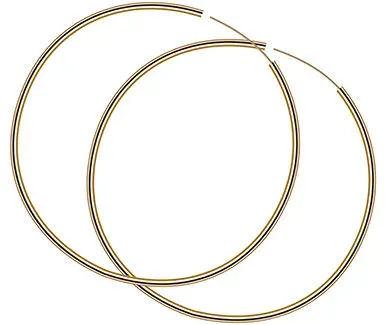 Part of what we now know as Eastern Europe was part of the Ostrogothic kingdom from 489 to 553. Eastern Germanic women wore styles derived from late Roman jewelry and such pieces have been found in modern day Ukraine. Many examples of hoop earrings, for example, have been found and often with beads at their base that have fourteen sides. Some versions are made in silver or gold and are decorated simply with the polyhedral beads. Others are inlaid with semi-precious stones and glass. Some were so elaborate as to have two wires twisted to form the hoop or were fashioned from granulated metals. Brooches have also been found in Ukraine such that were worn as a pair: these would hold their ankle-length dresses together at the shoulder and were sometimes made with copper alloys overlaid with silver. Earrings, bracelets, rings necklaces and belt buckles have also been found. One belt buckle is made from gilt silver with
Part of what we now know as Eastern Europe was part of the Ostrogothic kingdom from 489 to 553. Eastern Germanic women wore styles derived from late Roman jewelry and such pieces have been found in modern day Ukraine. Many examples of hoop earrings, for example, have been found and often with beads at their base that have fourteen sides. Some versions are made in silver or gold and are decorated simply with the polyhedral beads. Others are inlaid with semi-precious stones and glass. Some were so elaborate as to have two wires twisted to form the hoop or were fashioned from granulated metals. Brooches have also been found in Ukraine such that were worn as a pair: these would hold their ankle-length dresses together at the shoulder and were sometimes made with copper alloys overlaid with silver. Earrings, bracelets, rings necklaces and belt buckles have also been found. One belt buckle is made from gilt silver with ![]() garnet inlay and is molded into the form of an eagle. Metalworking in the region grew quite sophisticated and men and women were at times buried in shirts with gold foil appliqu�s sewn onto the sleeves and necklines. These metal sheets were punched and pressed to create various patterns. One ruler is described as having worn a robe decorated with hundreds of such appliqu�s.
garnet inlay and is molded into the form of an eagle. Metalworking in the region grew quite sophisticated and men and women were at times buried in shirts with gold foil appliqu�s sewn onto the sleeves and necklines. These metal sheets were punched and pressed to create various patterns. One ruler is described as having worn a robe decorated with hundreds of such appliqu�s.
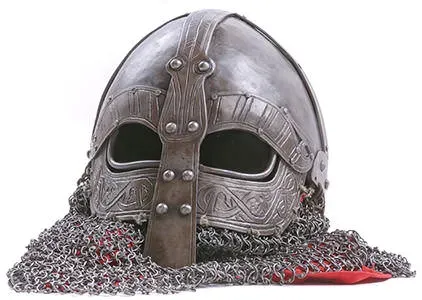 In 793, the Vikings invaded many sites all over Europe. Their decorative system included patterns of curved lines weaving over and under one another. These lines were at times capped off with animal heads. Such geometric patterns were used in print but also in jewelry. In southern Norway in 850, a Viking sailing ship was used for burial and filled with riches very representative of these styles. The Vikings mixed with local Slavs and formed the kingdom of Rus', whose capital was Kiev. Rus' maintained an ongoing cultural and political relationship with Byzantium to the south, alternating between trading with Constantinople and attacking the city. The art and architecture of Byzantium therefore continued to influence the design of the region. Vikings also sustained the Silk Road from the Turkic Khazarian Empire in southeastern Europe across the Baltic Sea all the way through northwestern Europe.
In 793, the Vikings invaded many sites all over Europe. Their decorative system included patterns of curved lines weaving over and under one another. These lines were at times capped off with animal heads. Such geometric patterns were used in print but also in jewelry. In southern Norway in 850, a Viking sailing ship was used for burial and filled with riches very representative of these styles. The Vikings mixed with local Slavs and formed the kingdom of Rus', whose capital was Kiev. Rus' maintained an ongoing cultural and political relationship with Byzantium to the south, alternating between trading with Constantinople and attacking the city. The art and architecture of Byzantium therefore continued to influence the design of the region. Vikings also sustained the Silk Road from the Turkic Khazarian Empire in southeastern Europe across the Baltic Sea all the way through northwestern Europe.
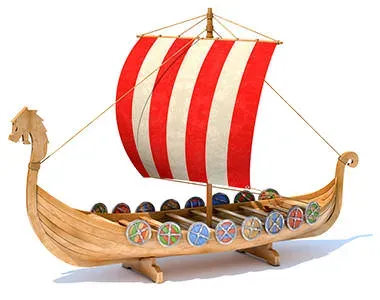 Viking voyages ceased as, in the tenth century, various kings in Scandinavia and Eastern Europe converted to Christianity. However, the aesthetic of the Vikings lasted in Christian art for some time; even in 1150, Polish churches were still being finished with the graceful interlace typical of Viking art. Dragon heads, richly carved metals and colorful accents were typical of everything from church interiors to bracelets. Grand Prince Vladimir considered Islam, Judaism and Catholicism before adopting Orthodox Christianity as the religion of Rus' in 988. His decision was influenced by a desire to affirm his relationship with the Byzantine Empire and many of the cultural products of his reign ï¾– including items as large as churches and as small as jewels ï¾– were fashioned in styles adapted from Byzantium.
Viking voyages ceased as, in the tenth century, various kings in Scandinavia and Eastern Europe converted to Christianity. However, the aesthetic of the Vikings lasted in Christian art for some time; even in 1150, Polish churches were still being finished with the graceful interlace typical of Viking art. Dragon heads, richly carved metals and colorful accents were typical of everything from church interiors to bracelets. Grand Prince Vladimir considered Islam, Judaism and Catholicism before adopting Orthodox Christianity as the religion of Rus' in 988. His decision was influenced by a desire to affirm his relationship with the Byzantine Empire and many of the cultural products of his reign ï¾– including items as large as churches and as small as jewels ï¾– were fashioned in styles adapted from Byzantium.
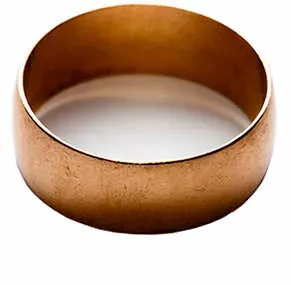 In fact, styles from Western Europe continued to influence those in Eastern Europe throughout the first few centuries of the millennium. French Romanesque trends influenced Scandinavians and Danes; German concepts influenced Poles. South of Rus', the Khazar region stood at the center of a trade nexus between western Europe, Central Asia, and the Muslim world. Gravesites have been found throughout the region from which bronze jewelry has been excavated: prong settings on rings, intricate scrollwork on pins and brooches, dangling adornments. Judaism was, by the ninth century at the latest, widespread among Khazars and Jewish women have worn wedding rings since the seventh century. Such rings would not have had stones set into them and in this region were probably made of bronze.
In fact, styles from Western Europe continued to influence those in Eastern Europe throughout the first few centuries of the millennium. French Romanesque trends influenced Scandinavians and Danes; German concepts influenced Poles. South of Rus', the Khazar region stood at the center of a trade nexus between western Europe, Central Asia, and the Muslim world. Gravesites have been found throughout the region from which bronze jewelry has been excavated: prong settings on rings, intricate scrollwork on pins and brooches, dangling adornments. Judaism was, by the ninth century at the latest, widespread among Khazars and Jewish women have worn wedding rings since the seventh century. Such rings would not have had stones set into them and in this region were probably made of bronze.
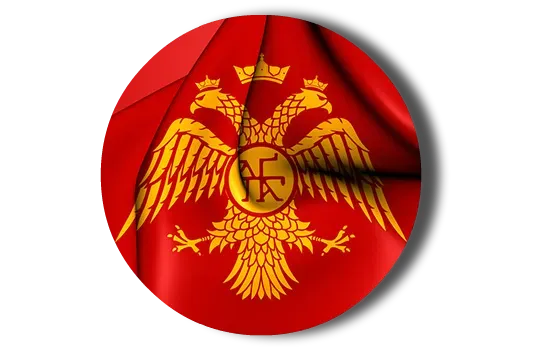 Khazar imperial power was destroyed by Rus' by the 960s and in 1236, the Mongols swept across Central Asia. Settling in the Russian steppe, they curtailed the power of Rus', disrupting the country's relationship with the Byzantine Empire and with the West. The region suffered in terms of political fragmentation and a kind of isolated development, but the Mongols were tolerant of local religions and the customs of daily life. Some argue that if not for the Mongol invasion, Rus' would never have evolved into the Russian tsardom and the Russian empire, developments which happened over the following few centuries. In any case, the invasion held local tastes in check, so if the artisans of Rus' were not in contact with the Byzantine Empire, they were still using its stylistic motifs.
Khazar imperial power was destroyed by Rus' by the 960s and in 1236, the Mongols swept across Central Asia. Settling in the Russian steppe, they curtailed the power of Rus', disrupting the country's relationship with the Byzantine Empire and with the West. The region suffered in terms of political fragmentation and a kind of isolated development, but the Mongols were tolerant of local religions and the customs of daily life. Some argue that if not for the Mongol invasion, Rus' would never have evolved into the Russian tsardom and the Russian empire, developments which happened over the following few centuries. In any case, the invasion held local tastes in check, so if the artisans of Rus' were not in contact with the Byzantine Empire, they were still using its stylistic motifs.
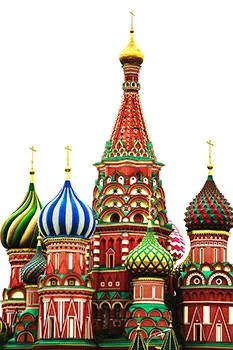 The Rus' are the predecessors of Russians, Belarusians, and Ukrainians. Ivan III consolidated the power of Russia in Muscovy in the 15th century, inviting Italian architects to Moscow to work on the monuments of the Kremlin. Many princes flocked to his court, all trying to outdo the other in terms of their fashionable clothing, jewelry and apartments. Gorgeous metalwork is found from this period: including beaten gold inlaid with
The Rus' are the predecessors of Russians, Belarusians, and Ukrainians. Ivan III consolidated the power of Russia in Muscovy in the 15th century, inviting Italian architects to Moscow to work on the monuments of the Kremlin. Many princes flocked to his court, all trying to outdo the other in terms of their fashionable clothing, jewelry and apartments. Gorgeous metalwork is found from this period: including beaten gold inlaid with ![]() sapphire, almandine, tourmaline, emeralds,
sapphire, almandine, tourmaline, emeralds, ![]() turquoise and pearls all at once. Granulated and filigreed, crowns were worn at coronation ceremonies and festivities, or kept in vaults. Princes gave gifts to Ivan and to one another, often as elaborate as their own possessions. In the meantime, Constantinople ï¾– the Byzantine capital ï¾– had fallen, so though some icon painters in the Ukraine still tried to use pre-fall icons as models for their own, most of Eastern Europe was beginning to use Western European influences in their craft, and also really developing their own distinct styles. From the twelfth to the fifteenth centuries, princedoms were in fact competing to promote the quality of their own native crafts. Independent schools of gold and silversmithing emerged.
turquoise and pearls all at once. Granulated and filigreed, crowns were worn at coronation ceremonies and festivities, or kept in vaults. Princes gave gifts to Ivan and to one another, often as elaborate as their own possessions. In the meantime, Constantinople ï¾– the Byzantine capital ï¾– had fallen, so though some icon painters in the Ukraine still tried to use pre-fall icons as models for their own, most of Eastern Europe was beginning to use Western European influences in their craft, and also really developing their own distinct styles. From the twelfth to the fifteenth centuries, princedoms were in fact competing to promote the quality of their own native crafts. Independent schools of gold and silversmithing emerged.
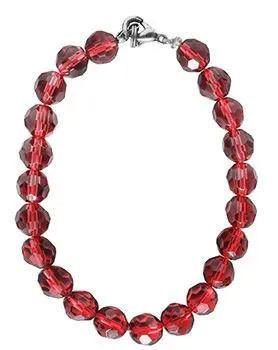 In Poland in the fifteenth century, hybrids of East and West were visible throughout artistic and craft traditions. Wladislaw II Jagiello of Poland-Lithuania had dominion over land from Prussia to Muscovy, but Ivan III began to gather provinces for Russia, absorbing Novgorod, Yaroslavl, Rostov and Tver. Ivan was the first grand duke to be acknowledged as something of a successor to the Byzantine emperor, and it was with his reign that the style ï¾– if not the name ï¾– of tsar commenced. Meanwhile in Czech and Slovak lands, glassmaking was a growing craft and their glowing red beads were being traded far and wide. In 1492, it was a necklace of Czech beads that Columbus offered to natives in San Salvador as a gesture of peace. In Prussia, Duke Albert controlled the lucrative Baltic trade in
In Poland in the fifteenth century, hybrids of East and West were visible throughout artistic and craft traditions. Wladislaw II Jagiello of Poland-Lithuania had dominion over land from Prussia to Muscovy, but Ivan III began to gather provinces for Russia, absorbing Novgorod, Yaroslavl, Rostov and Tver. Ivan was the first grand duke to be acknowledged as something of a successor to the Byzantine emperor, and it was with his reign that the style ï¾– if not the name ï¾– of tsar commenced. Meanwhile in Czech and Slovak lands, glassmaking was a growing craft and their glowing red beads were being traded far and wide. In 1492, it was a necklace of Czech beads that Columbus offered to natives in San Salvador as a gesture of peace. In Prussia, Duke Albert controlled the lucrative Baltic trade in ![]() amber. Amber was first used for medicinal purposes ï¾– consumed as a powder ground from the stone and dissolved in wine. Its healing powers were also harnessed by placing a piece of the stone or some powder in a vial worn around the neck. This was the way it began to be worn on the body and it quickly became a popular choice for jewelrymaking.
amber. Amber was first used for medicinal purposes ï¾– consumed as a powder ground from the stone and dissolved in wine. Its healing powers were also harnessed by placing a piece of the stone or some powder in a vial worn around the neck. This was the way it began to be worn on the body and it quickly became a popular choice for jewelrymaking.
 During the 16th century in Poland-Lithuania, political stability, prosperity due to grain exports and cultural achievement peaked. These fortunate people came from extremely diverse backgrounds, and a theory developed at the time to help to bring them together. Sarmatism ï¾– the idea that all Polish-Lithuanians descended from Sarmatians ï¾– became very popular, and nobles commissioned works of art and craft to celebrate their national pedigree. This was the Golden Age for this region, and Germans supplied affluent Polish with jewelry from a thriving Augsburg.
During the 16th century in Poland-Lithuania, political stability, prosperity due to grain exports and cultural achievement peaked. These fortunate people came from extremely diverse backgrounds, and a theory developed at the time to help to bring them together. Sarmatism ï¾– the idea that all Polish-Lithuanians descended from Sarmatians ï¾– became very popular, and nobles commissioned works of art and craft to celebrate their national pedigree. This was the Golden Age for this region, and Germans supplied affluent Polish with jewelry from a thriving Augsburg.
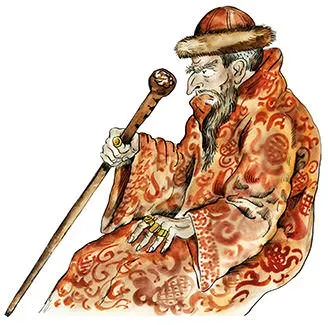 Ivan IV ï¾– the Terrible ï¾– was crowned Russia's first tsar at 17. He consolidated power in Moscow, but by the next coronation ï¾– of Michael in 1613 ï¾– the imperial treasury was empty. The new crown fashioned for the ceremony, though impressively decorated with gold and jewels, had to be paid for by the Stroganovs, a family whose wealth derived from their investment in Ural mines. Similar trends were happening in Poland, where nobility were gaining power and wealth while the king's prestige and treasury declined. There is, however, no shortage of wonderful artifacts from seventeenth century Eastern Europe: one crown made in Moscow in 1682 starts with a rich brown sable fur base, moves up in a simple beaten gold dome towards a smaller such dome ï¾– both of which are lightly and symmetrically inlaid with precious stones ï¾– and culminates in a simple cross dotted with pearls.
Ivan IV ï¾– the Terrible ï¾– was crowned Russia's first tsar at 17. He consolidated power in Moscow, but by the next coronation ï¾– of Michael in 1613 ï¾– the imperial treasury was empty. The new crown fashioned for the ceremony, though impressively decorated with gold and jewels, had to be paid for by the Stroganovs, a family whose wealth derived from their investment in Ural mines. Similar trends were happening in Poland, where nobility were gaining power and wealth while the king's prestige and treasury declined. There is, however, no shortage of wonderful artifacts from seventeenth century Eastern Europe: one crown made in Moscow in 1682 starts with a rich brown sable fur base, moves up in a simple beaten gold dome towards a smaller such dome ï¾– both of which are lightly and symmetrically inlaid with precious stones ï¾– and culminates in a simple cross dotted with pearls.
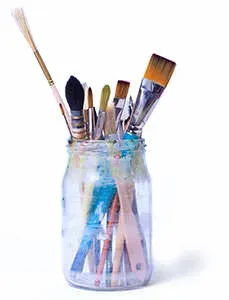 In the eighteenth century, the various individual crafts that had begun to pop up in the region really reached a peak. In Rostov, Russia, a workshop in the art of painting on enamel occurred at the archbishop's house. Later, the skill was applied to the making of small icons and by the nineteenth century, enamel goods were being produced on a mass scale, with separate artists specializing in different stages of the process. Other than painted enamel, precious stones were popular in and out of jewelry circles. In 1785,
In the eighteenth century, the various individual crafts that had begun to pop up in the region really reached a peak. In Rostov, Russia, a workshop in the art of painting on enamel occurred at the archbishop's house. Later, the skill was applied to the making of small icons and by the nineteenth century, enamel goods were being produced on a mass scale, with separate artists specializing in different stages of the process. Other than painted enamel, precious stones were popular in and out of jewelry circles. In 1785, ![]() lapis lazuli, alabaster,
lapis lazuli, alabaster, ![]() agate, malachite,
agate, malachite, ![]() jasper, and porphyry adorned not a crown but marble rooms in the Agate Pavilion at a Russian palace.
jasper, and porphyry adorned not a crown but marble rooms in the Agate Pavilion at a Russian palace.
 In the early eighteenth century, Peter the Great traveled extensively and brought many Western trends to Russia, some of which influenced jewelry innovations. Before Peter there were gold and silversmiths, but during his reign the term jeweler ï¾– or yuvelir ï¾– was introduced to the Russian language. Foreign jewelers worked in Russia, and were especially fond of working with diamonds. German jewelers made medals extremely popular as bodily ornamentation. In 1712, Peter established the Imperial Armory at Tula where craftsmen used a variety of ways of working metal to create intricately ornamented objects including jewelry. Even if the pieces ended up as furniture, they were delicate as well as durable. Throughout the 1730s, pseudo-Chinese styles were popular in the Baltic region, and lacquer was in common use.
In the early eighteenth century, Peter the Great traveled extensively and brought many Western trends to Russia, some of which influenced jewelry innovations. Before Peter there were gold and silversmiths, but during his reign the term jeweler ï¾– or yuvelir ï¾– was introduced to the Russian language. Foreign jewelers worked in Russia, and were especially fond of working with diamonds. German jewelers made medals extremely popular as bodily ornamentation. In 1712, Peter established the Imperial Armory at Tula where craftsmen used a variety of ways of working metal to create intricately ornamented objects including jewelry. Even if the pieces ended up as furniture, they were delicate as well as durable. Throughout the 1730s, pseudo-Chinese styles were popular in the Baltic region, and lacquer was in common use.
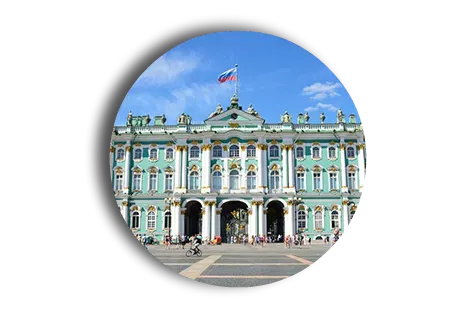 Peter wanted to house the jewelry collection of the Russian State in a permanent fund. He declared the fund inviolate ï¾– nothing could be sold ï¾– and each ensuing Emperor was mandated to leave a certain number of pieces in the fund. He started this collection with fifteenth, sixteenth and seventeenth century jewelry as well as all of the pieces used in his coronation ceremony. The pieces were kept in the Winter Palace in St. Petersburg.
Peter wanted to house the jewelry collection of the Russian State in a permanent fund. He declared the fund inviolate ï¾– nothing could be sold ï¾– and each ensuing Emperor was mandated to leave a certain number of pieces in the fund. He started this collection with fifteenth, sixteenth and seventeenth century jewelry as well as all of the pieces used in his coronation ceremony. The pieces were kept in the Winter Palace in St. Petersburg.
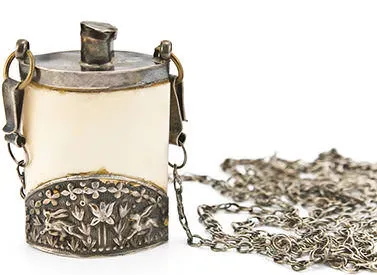 Peter's daughter, Elizabeth, contributed beautiful examples of Rococo jewelry to the fund. Her reign is characterized by a liberal use of precious stones, often set into whimsical designs that incorporated flowers in bouquet-like formations, sometimes even buzzing with bejeweled bees. These pieces were very much inspired by French ornamentation, as Elizabeth was fond of purchasing jewelry when she was in France. Snuffboxes were quite popular and quite as elaborate in their jeweled design.
Peter's daughter, Elizabeth, contributed beautiful examples of Rococo jewelry to the fund. Her reign is characterized by a liberal use of precious stones, often set into whimsical designs that incorporated flowers in bouquet-like formations, sometimes even buzzing with bejeweled bees. These pieces were very much inspired by French ornamentation, as Elizabeth was fond of purchasing jewelry when she was in France. Snuffboxes were quite popular and quite as elaborate in their jeweled design.
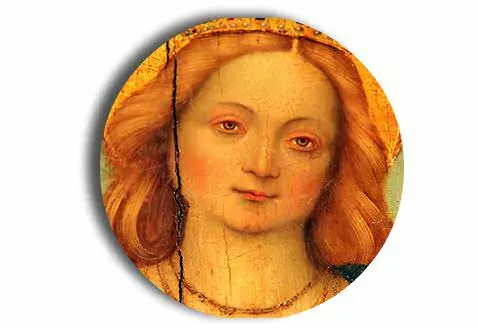 Catherine the Great was Empress in the late eighteenth century and she added many jewels to the State fund. She loved amethysts and many of the pieces she wore were set with the purple stone. She also loved Britain; attracted initially to the country's literature, she ended up importing British jewelry designers to Russia along with many other artisans. Eager to differentiate herself from Elizabeth's tastes, Catherine the Great's style was more Neoclassical. Catherine's son Paul also contributed interesting pieces to the State Fund, including the Blue Diamond Stickpin, originally a ring for the finger. Unfortunately, many eighteenth century jewelers broke up old jewels to produce new styles, and so the Russian jewelry collection is important for its preservation of wonderful and rare examples of period jewelry.
Catherine the Great was Empress in the late eighteenth century and she added many jewels to the State fund. She loved amethysts and many of the pieces she wore were set with the purple stone. She also loved Britain; attracted initially to the country's literature, she ended up importing British jewelry designers to Russia along with many other artisans. Eager to differentiate herself from Elizabeth's tastes, Catherine the Great's style was more Neoclassical. Catherine's son Paul also contributed interesting pieces to the State Fund, including the Blue Diamond Stickpin, originally a ring for the finger. Unfortunately, many eighteenth century jewelers broke up old jewels to produce new styles, and so the Russian jewelry collection is important for its preservation of wonderful and rare examples of period jewelry.
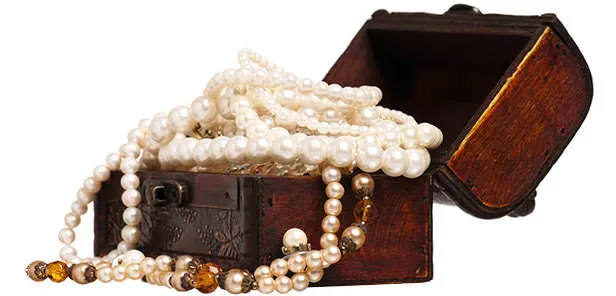 Russia boldly resisted the Napoleonic invasion in 1812, a success that really encouraged their nationalistic sentiment. In the nineteenth century, Russian jewelers began to abandon European styles ï¾– especially those of the French ï¾– and to really hone a Russian style. They began to use freshwater pearls that were found locally in northern Russian rivers, and Russian jewelers made names for themselves on the international market. This includes Peter Faberge, who, though French in terms of ancestry, was born and raised in Russia. Nineteenth century jewelers targeted both international royalty and middle class Russians for the first time. This is sometimes called the golden age of Russian jewelry, with its exquisite silverwork, alloyed gold, unique settings of precious stones next to semi-precious, and delightful animal and egg sculptures. This period is also sometimes called a period of Russian Classicism and Historicism. Each ruler of Russia continued to contribute wonderful pieces to the state collection, pieces representative of their time period as well as antiques; the Imperial jewel collection became one of the most important in the world.
Russia boldly resisted the Napoleonic invasion in 1812, a success that really encouraged their nationalistic sentiment. In the nineteenth century, Russian jewelers began to abandon European styles ï¾– especially those of the French ï¾– and to really hone a Russian style. They began to use freshwater pearls that were found locally in northern Russian rivers, and Russian jewelers made names for themselves on the international market. This includes Peter Faberge, who, though French in terms of ancestry, was born and raised in Russia. Nineteenth century jewelers targeted both international royalty and middle class Russians for the first time. This is sometimes called the golden age of Russian jewelry, with its exquisite silverwork, alloyed gold, unique settings of precious stones next to semi-precious, and delightful animal and egg sculptures. This period is also sometimes called a period of Russian Classicism and Historicism. Each ruler of Russia continued to contribute wonderful pieces to the state collection, pieces representative of their time period as well as antiques; the Imperial jewel collection became one of the most important in the world.
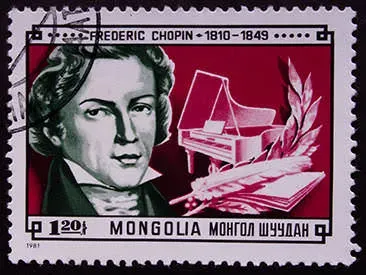 In Poland, the nineteenth century was the Romantic Era, generating the music of Mickiewicz and Chopin. This, of course, happened against the complicated political backdrop of the nineteenth century, including an initial occupation by Napoleon, then by Russia, then a series of failed revolts against Russia and Austria. Polish people at this point were decorating their bodies with beautiful embroidered sashes, metalwork buttons and belts full of Christian iconography. Royalty sported scepters and crowns cast out of gold and set with precious stones.
In Poland, the nineteenth century was the Romantic Era, generating the music of Mickiewicz and Chopin. This, of course, happened against the complicated political backdrop of the nineteenth century, including an initial occupation by Napoleon, then by Russia, then a series of failed revolts against Russia and Austria. Polish people at this point were decorating their bodies with beautiful embroidered sashes, metalwork buttons and belts full of Christian iconography. Royalty sported scepters and crowns cast out of gold and set with precious stones.
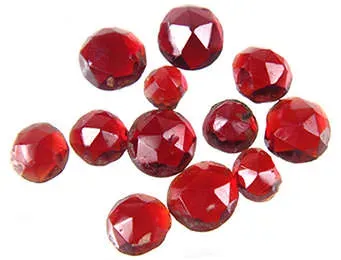 At the turn of the twentieth century, Eastern European artists were in close contact with those in Western Europe. Russian artists were especially interested in abstraction and were at the forefront of its exploration before the Revolution in 1917. World War I (1914-1918) changed everything. All partition powers collapsed and the Second Republic of Poland was founded. The Czechs and Slovaks were freed from the rule of Austria and Hungary and united as Czechoslovakia. Prior to WWI, jewelry from this region was often unmarked but called Bohemian. After WWI and until 1992, the jewelry was marked with some version of the word "Czechoslovakia."" A lot of glass beads were used in Czechoslovakian jewelry: faceted, marbled, square, and of many different colors. Throughout the 20s and 40s, Czechoslovakian jewelry incorporated Deco styles. Pyrope garnets are found in the region, and this deep red semi-precious stone has been used by people in the region to make jewelry for 300 years."
At the turn of the twentieth century, Eastern European artists were in close contact with those in Western Europe. Russian artists were especially interested in abstraction and were at the forefront of its exploration before the Revolution in 1917. World War I (1914-1918) changed everything. All partition powers collapsed and the Second Republic of Poland was founded. The Czechs and Slovaks were freed from the rule of Austria and Hungary and united as Czechoslovakia. Prior to WWI, jewelry from this region was often unmarked but called Bohemian. After WWI and until 1992, the jewelry was marked with some version of the word "Czechoslovakia."" A lot of glass beads were used in Czechoslovakian jewelry: faceted, marbled, square, and of many different colors. Throughout the 20s and 40s, Czechoslovakian jewelry incorporated Deco styles. Pyrope garnets are found in the region, and this deep red semi-precious stone has been used by people in the region to make jewelry for 300 years."
 The Russian Revolution of 1917 ended tsarist Russia and the Bolsheviks seized power. They soon changed their name to the Communist Party and by 1922, the Soviet Union was formed, including many republics with distinct aesthetic traditions including Armenia, Azerbaijan, Belarus, Estonia, Georgia, Kazakhstan, Kyrgyzstan, Latvia, Lithuania, Moldova, Russia, Tajikstan, Turkmenistan, Ukraine, and Uzbekistan. The Communist government supported Socialist Realism and not abstraction. The subject of most works of art and indeed jewelry, even enamel painting, was to be supportive of the state.
The Russian Revolution of 1917 ended tsarist Russia and the Bolsheviks seized power. They soon changed their name to the Communist Party and by 1922, the Soviet Union was formed, including many republics with distinct aesthetic traditions including Armenia, Azerbaijan, Belarus, Estonia, Georgia, Kazakhstan, Kyrgyzstan, Latvia, Lithuania, Moldova, Russia, Tajikstan, Turkmenistan, Ukraine, and Uzbekistan. The Communist government supported Socialist Realism and not abstraction. The subject of most works of art and indeed jewelry, even enamel painting, was to be supportive of the state.
 The Russian State collection of jewels was moved to Moscow during World War I and placed in vaults beneath the Kremlin, where the jewels were forgotten during all the political turmoil. Found at the Kremlin in 1926, they were catalogued and photographed. Some were sold to a consortium in America and others were dispersed around the globe. Soviet era rulers did not contribute to the fund. Thankfully, many important pieces remained in the collection including a wonderful smattering of eighteenth and nineteenth century jewels as well as the coronation pieces. Some are now exhibited at the Kremlin Armory Museum in Moscow and the fund is now called the State Diamond Fund of the Russian Federation.
The Russian State collection of jewels was moved to Moscow during World War I and placed in vaults beneath the Kremlin, where the jewels were forgotten during all the political turmoil. Found at the Kremlin in 1926, they were catalogued and photographed. Some were sold to a consortium in America and others were dispersed around the globe. Soviet era rulers did not contribute to the fund. Thankfully, many important pieces remained in the collection including a wonderful smattering of eighteenth and nineteenth century jewels as well as the coronation pieces. Some are now exhibited at the Kremlin Armory Museum in Moscow and the fund is now called the State Diamond Fund of the Russian Federation.
 The second half of the twentieth century ï¾– after World War II ï¾– was a difficult time for craftsmen in Eastern Europe. Many political regimes in the region looked unfavorably on certain kinds of jewelrymaking. For example, in Romania, it was illegal to possess precious metals in any but the smallest quantities. One could not export diamonds or jewelry or indeed engage in foreign trade of such merchandise at all. Not only were there aesthetic rules, then, governing the production of fine pieces, but there were commercial restrictions as well. Besides, the general populations were not wealthy. In the late 1980s, as Gorbachev led the Soviet Union, there were liberalizing trends throughout Eastern Europe, but economic struggle remained an issue.
The second half of the twentieth century ï¾– after World War II ï¾– was a difficult time for craftsmen in Eastern Europe. Many political regimes in the region looked unfavorably on certain kinds of jewelrymaking. For example, in Romania, it was illegal to possess precious metals in any but the smallest quantities. One could not export diamonds or jewelry or indeed engage in foreign trade of such merchandise at all. Not only were there aesthetic rules, then, governing the production of fine pieces, but there were commercial restrictions as well. Besides, the general populations were not wealthy. In the late 1980s, as Gorbachev led the Soviet Union, there were liberalizing trends throughout Eastern Europe, but economic struggle remained an issue.
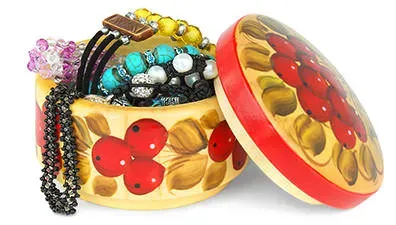 Now, since the late ム90s, there has been a new rush to create high quality creative pieces of jewelry in Eastern Europe and especially in Russia. Contemporary Russian design includes many references to modern art and has also been inspired by the years of cultural isolation its citizens went through. This region, so rich in history and natural resources, is producing exciting new work for our times and for the future.
Now, since the late ム90s, there has been a new rush to create high quality creative pieces of jewelry in Eastern Europe and especially in Russia. Contemporary Russian design includes many references to modern art and has also been inspired by the years of cultural isolation its citizens went through. This region, so rich in history and natural resources, is producing exciting new work for our times and for the future.